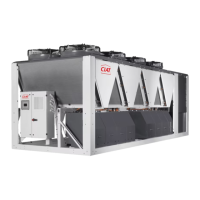EN-7 POWERCIAT LX ST/HE/XE
Do not unweld or amecut the refrigerant lines or any
refrigerant circuit component until all refrigerant (liquid and
vapour) as well as the oil have been removed from chiller.
Traces of vapour should be displaced with dry air nitrogen.
Refrigerant in contact with an open ame produces toxic
gases.
The necessary protection equipment must be available, and
appropriate fire extinguishers for the system and the
refrigerant type used must be within easy reach.
Do not siphon refrigerant.
Avoid spilling liquid refrigerant on skin or splashing it into
the eyes. Use safety goggles and safety gloves. Wash any
spills from the skin with soap and water. If liquid refrigerant
enters the eyes, immediately and abundantly ush the eyes
with water and consult a doctor.
The accidental releases of the refrigerant, due to small leaks
or signicant discharges following the rupture of a pipe or
an unexpected release from a safety valve, can cause
frostbites and burns to personnel exposed. Do not ignore
such injuries. Installers, owners and especially service
engineers for these units must:
• Seek medical attention before treating such injuries.
• Have access to a rst-aid kit, especially for treating eye
injuries.
We recommend to apply standard EN 378-3 Annex 3.
Never apply an open ame or live steam to a refrigerant
container. Dangerous overpressure can result. If it is
necessary to heat refrigerant, use only warm water.
During refrigerant removal and storage operations follow applicable
regulations. These regulations, permitting conditioning and recovery
of halogenated hydrocarbons under optimum quality conditions for
the products and optimum safety conditions for people, property
and the environment are described in standard NF E29-795.
Any refrigerant transfer and recovery operations must be carried
out using a transfer unit. A 3/8” SAE connector on the manual
liquid line valve is supplied with all units for connection to the
transfer station. The units must never be modied to add refrigerant
and oil charging, removal and purging devices. All these devices
are provided with the units. Please refer to the certied dimensional
drawings for the units.
Do not re-use disposable (non-returnable) cylinders or
attempt to rell them. It is dangerous and illegal. When
cylinders are empty, evacuate the remaining gas pressure,
and move the cylinders to a place designated for their
recovery. Do not incinerate them.
Only use R134a refrigerant, in accordance with AHRI
Standard 700 (published by the US Air conditioning,
Heating and Refrigeration Institute). The use of any
other refrigerant may expose users and operators
to unexpected risks.
Do not attempt to remove refrigerant circuit components or
ttings, while the machine is under pressure or while it is
running. Be sure pressure is at 0 kPa and that the unit has
been shut-down and de-energised before removing
components or opening a circuit.
Do not attempt to repair or recondition any safety devices
when corrosion or build-up of foreign material (rust, dirt,
scale, etc.) is found within the valve body or mechanism.
If necessary, replace the device. Do not install relief valves
in series or backwards.
No part of the unit must be used as a walkway, rack
or support. Periodically check and repair or if
necessary replace any component or piping that
shows signs of damage.
The refrigerant lines can break under the weight and release
refrigerant, causing personal injury.
Do not climb on a machine. Use a platform, or staging to
work at higher levels.
Use mechanical lifting equipment (crane, hoist, winch, etc.)
to lift or move heavy components. For lighter components,
use lifting equipment when there is a risk of slipping or losing
your balance.
Use only original replacement parts for any repair or
component replacement. Consult the list of replacement
parts that corresponds to the specication of the original
equipment.
Do not drain water circuits containing industrial brines,
without informing the technical service department at the
installation site or a competent body rst.
Close the entering and leaving water shutoff valves and
purge the unit water circuit, before working on the
components installed on the circuit (screen lter, pump,
water ow switch, etc.).
Do not loosen the water box bolts until the water boxes have
been completely drained.
Periodically inspect all valves, ttings and pipes of the
refrigerant and hydraulic circuits to ensure that they do not
show any corrosion or any signs of leaks.
It is recommended to wear ear defenders, when working
near the unit and the unit is in operation.
1 - INTRODUCTION

